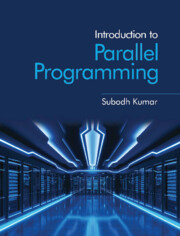Book contents
- Frontmatter
- Dedication
- Contents
- List of Figures
- Introduction
- 1 An Introduction to Parallel Computer Architecture
- 2 Parallel Programming Models
- 3 Parallel Performance Analysis
- 4 Synchronization and Communication Primitives
- 5 Parallel Program Design
- 6 Middleware: The Practice of Parallel Programming
- 7 Parallel Algorithms and Techniques
- Bibliography
- Index
5 - Parallel Program Design
Published online by Cambridge University Press: 27 October 2022
- Frontmatter
- Dedication
- Contents
- List of Figures
- Introduction
- 1 An Introduction to Parallel Computer Architecture
- 2 Parallel Programming Models
- 3 Parallel Performance Analysis
- 4 Synchronization and Communication Primitives
- 5 Parallel Program Design
- 6 Middleware: The Practice of Parallel Programming
- 7 Parallel Algorithms and Techniques
- Bibliography
- Index
Summary
Parallel programming is challenging. There are many parts interacting in a complex manner: algorithm-imposed dependency, scheduling on multiple execution units, synchronization, data communication capacity, network topology, memory bandwidth limit, cache performance in the presence of multiple independent threads accessing memory, program scalability, heterogeneity of hardware, and so on. It is useful to understand each of these aspects separately. We discuss general parallel design principles in this chapter. These ideas largely apply to both shared-memory style and message-passing style programming, as well as task-centric programs.
Question: How to devise the parallel solution to a given problem?
At first cut, there are two approaches to start designing parallel applications:
Question: What is the detailed structure of parallel programs?
1. Given a problem, design and implement a sequential algorithm, and then turn it into a parallel program based on the type of available parallel architecture.
2. Start ab initio. Design a parallel algorithm suitable for the underlying architecture and then implement it.
In either case, performance, correctness, reusability, and maintainability are important goals. We will see that for many problems, starting with a sequential algorithm and then dividing it into independent tasks that can execute in parallel leads to a poor parallel algorithm. Instead, another algorithm that is designed to maximize independent parts, may yield better performance. If a good parallel solution cannot be found – and there do exist inherently sequential problems, for which parallel solutions are not sufficiently faster than sequential ones – it may not be a problem worth solving in parallel.
Once a parallel algorithm is designed, it may yet contain parts that are sequential. Further, the parallel parts can also be executed on a sequential machine in an arbitrary sequence. Such “sequentialization” allows the developer to test parts of a parallel program. If a purely sequential version is already available, or can be implemented with only small effort, it can also serve as a starting point for parallel design. The sequential version can be exploited to develop the parallel application incrementally, gradually replacing sequential parts with their parallel versions. The sequential version also provides performance targets for the parallel version and allows debugging by comparing partial results.
Information
- Type
- Chapter
- Information
- Introduction to Parallel Programming , pp. 111 - 138Publisher: Cambridge University PressPrint publication year: 2023
Accessibility standard: Unknown
Why this information is here
This section outlines the accessibility features of this content - including support for screen readers, full keyboard navigation and high-contrast display options. This may not be relevant for you.Accessibility Information
- 1
- Cited by
